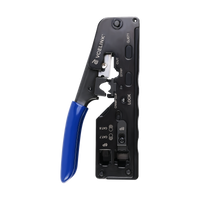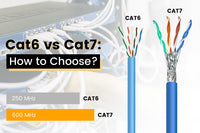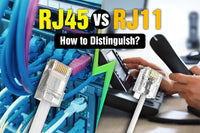If you look into the market and search for Ethernet cables, you’ll encounter a range of cable categories like Cat5e, Cat6, Cat6a, Cat7, and Cat8. For those unfamiliar with Ethernet cables, opting for the latest version, Cat8 might be the obvious choice for better performance.
Can Cat8 cables always be the right option? Should I choose Cat7 or Cat8 cables? The decision between Cat7 and Cat8 isn’t always straightforward.
Suppose you require a high-performance Ethernet cable for your business or just need a reliable option for personal use; what kind of Ethernet cable is the most suitable? This article aims to guide you through Cat7 and Cat8 Ethernet cables for more information.
Cat7 Ethernet Cable
Cat7 cable has a huge improvement over previous categories like Cat5e and Cat6 cables. Also known as Class F cable, Cat7 gained approval in 2002, aiming to support the maximum data transfer rate of 10 Gbps over a 100-meter (328-feet) distance.
Cat7 was defined by ISO/IEC 11801:2002 standard and was never officially approved by TIA/EIA in North America. Introduced in the same year as the Cat6 standard, Cat7 has achieved a giant leap. But it was considered too ahead of its time, lacking applications and devices that required its capabilities. Moreover, while you can find Cat7 RJ45 connectors on the market, they are not the original connectors for Cat7 cables; Cat7 cables use GG45 connector, which is not compatible with RJ45 connectors. Although less popular in North America compared to Cat6 and Cat6a, Cat7 finds extensive use in Europe, particularly in Germany, due to its adherence to strict regulations.
Cat8 Ethernet Cable
Cat8, developed by ANSI/TIA-568 standards and published in 2016, is the latest category in Ethernet cables. It is designed to transfer up to 40 Gbps of data at a maximum length of 30 meters. Cat8 Ethernet cables are all shielded to minimize external interference. The ANSI/TIA has designated two Cat8 cabling standards for 25 and 40 Gbps, respectively. Category 8.1 maintains backward compatibility with the RJ45 connector, while Category 8.2 is only compatible with GG45 connectors.
Cat7 vs Cat8 Comparison
Cat7 and Cat8 may seem very familiar at first glance. To comprehensively understand these categories, we’ll delve into a detailed comparison, exploring various aspects of Cat7 and Cat8 cables.
Cable Construction
Both Cat7 and Cat8 cables feature four twisted pairs, typically including shielding to enhance interference resistance. Cat7 cables utilize GG45 or TERA connectors for optimal performance. Unlike other categories recognized by TIA/EIA, such as Cat5e and Cat6 cables, Cat8 cables exclusively come in shielded types, and usually employ S/FTP to minimize alien crosstalk, EMI, and RFI.
Performance
The newest version can always be better. It is obvious that Cat8 cables outperform Cat7 cables. While Cat7 cables boast a maximum bandwidth of 600 MHz, Cat8 Ethernet cables surpass them with an impressive 2000 MHz maximum bandwidth. This difference in bandwidth directly impacts their data rates, with Cat8 cables supporting a data rate of 25/40 Gbps, while Cat7 Ethernet cables are limited to 10 Gbps. It’s worth noting that in real life, Cat7 cables typically exhibit performance similar to Cat6a cables.
Connector
Cat7 Ethernet cables are usually used with non-RJ45 connectors, which are less common on the market. Consequently, Cat7 cables may not be universally compatible with all equipment. Additionally, the use of these non-standard connectors contributes to higher costs during network installation. Cat8 uses RJ45 connectors for Class I and non-RJ45 connectors for Class II, so it is backward compatible with Cat6 and Cat6 cables and can be used for versatile use across different devices.
Maximum Running Length
It is known to all that the maximum running length for Ethernet cables is 100 meters (328 feet). Beyond this limit, you may encounter a decline in network speed. However, Cat7 and Cat8 cables have different distance limits for their best performance. While a Cat7 cable can sustain a 10 Gbps data rate over a 100-meter length, Cat8 is limited to 30 to 40 meters to achieve a 40 Gbps data rate.
|
Category |
Cat7 Ethernet Cable |
Cat8 Ethernet Cable |
|
Maximum Bandwidth |
600 MHz |
2000 Mhz |
|
Transmission Speed |
10 Gbps |
25/40 Gbps |
|
Distance |
100m |
30-40m |
|
Cable Construction |
Shielded |
Shielded |
|
Connector Type |
GG45 |
Class I: RJ45, Class II: Non-RJ45 |
|
TIA/EIA Recognition |
NO |
YES |
|
PoE |
✅ |
✅ |
Cat7 or Cat8 for Home Network?
People often pick the latest category cables, assuming they offer superior performance, but that’s not always the case. In reality, Cat7 or Cat8 cables can be overkill for your home network. Achieving a fast network speed isn’t solely contingent on the Ethernet cable; your home devices play a crucial role too. For most home applications, a 10 Gbps data rate is more than sufficient, and most consumer equipment is well-equipped to handle that. It is a general consensus that Cat6 or Cat6a is the best choice to keep a good balance between performance and cost for most individual uses.
However, if you have specific requirements or installation scenarios, such as demanding gaming and streaming needs with a focus on minimal latency and the highest data rate, then Cat8 cables could be worthwhile.
Which is More Future-proofing?
Data rate has become more and more important for a successful business. The Cat8 is the fastest Ethernet cable by far, with a data rate matching that of fiber optic cable. Cat8 cables can effectively address the network connection in data centers and server rooms, and the RJ45 connectors allow Cat8 cables to be compatible with all existing devices. Cat8 cables can be the prior choice for short-distance high-requirement networks, but fiber optic cables may be the best choice for long-distance high-speed networks.

For more information on this topic, you can keep up on our blogs. While VCELINK offers general and basic information for our customers and other visitors to the website, it’s not professional advice.




Be the first one to comment.
Leave a comment